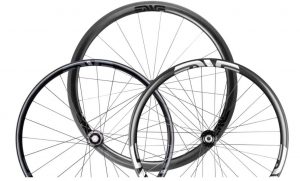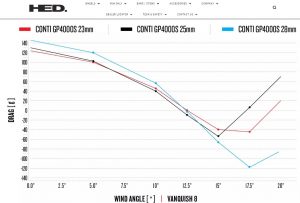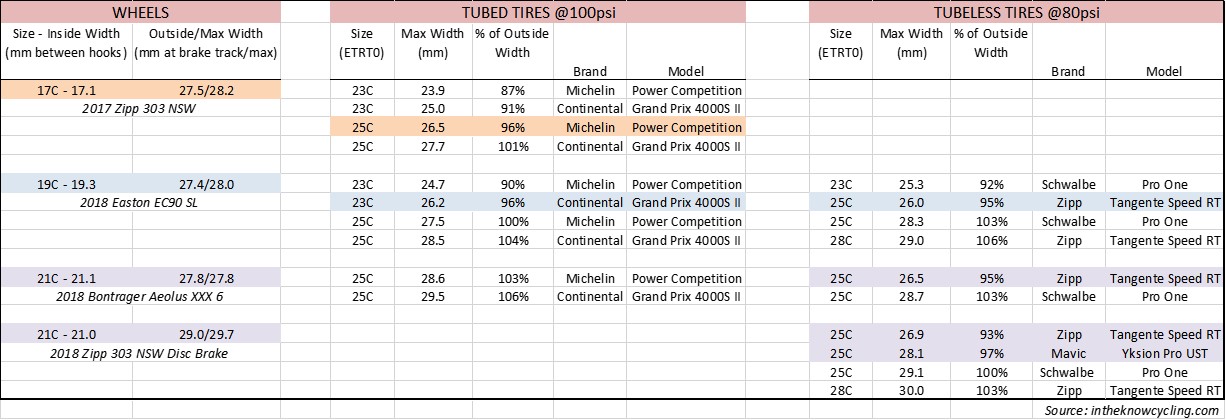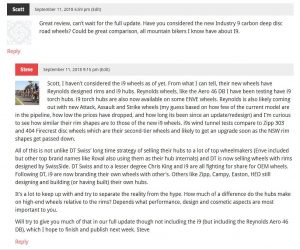KNOW’S NOTES – ENVE DEAL, TIRE WIDTHS, HUB MAKER WHEELS

This week’s Know’s Notes, my new, regular Friday post where I share a few interesting things I came to know in the past week includes a way to save $700-$1000 on new ENVE wheels, the reality about how wide your 25C tire really is, a comment on hub makers now selling wheels, another chance to tell me what you want to see reviewed, and who won the recent reader survey contest.
Let’s get rolling.
DEAL OF THE WEEK
ENVE TRADE IN AND TRADE UP PROGRAM – Riding a carbon wheelset that’s a few years old? Want a newer technology, better performing set but can’t justify spending the money and know you’d have a hard time getting much for your old one? Always wanted ENVE wheels but never seriously considered them because of their price?
Join the club.
Fortunately for me, I’ve been able to ride a number of ENVE wheels for In The Know Cycling reviews and rated them Best Performers in the climbing (SES 3.4), mid-depth aero (SES 4.5), and carbon disc (SES 4.5 AR) wheelset categories.
Maybe ENVE’s new program works for you too. They just announced a promotion where US residents can get a $700 credit toward the purchase of a new ENVE SES, M or G series wheelset when you trade in rideable, carbon wheels made another company or $1000 if you trade-in ENVE ones.
You occasionally see this kind of program for bikes and of course, all the time for cars, However, I’ve not seen this kind of deal before for wheelsets. With all the changes in carbon wheel shapes, widths and performance in the last couple years, this seems like a great way to get a new set of top performing wheels for the kind of discount you don’t see on current generation models.
It looks quite simple.
To do it online, you order and pay for your new ENVE wheels through the program link below at the discounted price and then return your trade-in wheels in the box the new ones come in with a prepaid shipping label provided by ENVE.
Or, you can send in your old wheels first with a prepaid label and then order your new ones. (Not sure why you’d want to do the second option…)
You can also take the wheels you want to trade-in to a bike shop that sells ENVE wheels, buy them from the shop if they have the ones you want in inventory or have them order a new set for you if they don’t.
Pretty cool. Maybe they’ll start a trend. That would be good.
Click on this link to the ENVE upgrade program to read more or put your order in.
TOPIC OF THE WEEK
Tire Width – In last week’s Know’s Notes, I wrote about and gave you a chart that showed what tire pressure you should ride your modern, wider 19C, and 21C road wheels at. I also got up on my soapbox to remind you of the importance of selecting the right tire brand and size to get the aero performance, rolling resistance, handling, and comfort you want from the wheels you have.
I wrote a post about this two years ago when the rim widths on most new wheels were going from 15C to 17C while cyclists were putting 25C tires on everything that moved because that was the hype cycle we were in back then.
Fast forward to 2018 and I haven’t seen a new 17C wheelset come through in while. I know they are still out there in great numbers especially on alloy wheels but most new carbon rim brake and disc brake wheels are 19C and 21C.
I measured up a bunch of tires from a handful of brands this week to give you my recommendations of what tire brand and sizes to use on the new, wider rims.
I also read an article published this past week where the author went on and on about how ETRTO, the European standards organization for car, tractors and bicycle tires was going to update its 35-year-old bike tire width guidelines. A prince must have kissed this Sleeping Beauty of an organization and told her about all that’s happened over the years like carbon rims and disc brake wheels and internal road rim widths increasing from the 13mm that were standard when they first wrote their recommendations to today’s 17mm, 19mm, and 21mm ones.
Being a European non-profit and with Mavic and Campagnolo, two rather behind-the-times wheel designers, being it’s only bike wheel manufacturer members, I’m not holding out much hope. Besides, most wheelmakers outside of Mavic, Campy/Fulcrum, and Shimano moved well beyond ETRTOs recommendations years ago, if they ever used them in the first place. And the bike tire makers that are part of ETRTO – Continental, Schwalbe, Michelin, and Pirelli – show no consistency in their tire sizing even though, as members, they are supposed to adhere to the organization’s guidelines.
As you likely know from your own experience, the 23C, 25C, and 28C tire designations don’t mean the tires carrying those designations will measure 23mm, 25mm, and 28mm once mounted and inflated on wheels. Today’s most popular tires measure 2-3mm wider than their C size suggests depending on the size rim you mount and inflate them on your wheels.
To further complicate matters, some tire makers have resized their latest lines so that they now actually measure closer to what’s stated on the box while others haven’t.
If you are trying to optimize for aero performance (tire width no greater than 95% of rim width), rolling resistance (wider tires have less), handling (wider tires give you wider tire patch) and comfort (wider tires at lower pressures are more comfortable), then not knowing what a tire will actually measure on your rim when you buy a 23C, 25C or 28C tire is kind of like throwing darts with a blindfold on to make your selection.
If you don’t ride at aero speeds (18-20 mph/29-32kph and up) or don’t have at least some aero depth and shape to your rims (at least 35mm deep and not a box section or straight V profile), none of this matters. And if you favor comfort over speed and don’t care about getting those last few watts out of your gear, forget all of this.
But if you want to go fast, pick gear to help you do it, ride at or north of aero speeds, and have U or toroid profile wheels that are 40, 50 or 60 mm deep, actual tire width matters a lot, at least if you consider 2 to 5 watts to be a lot.
Take a look at the difference in aero performance of 23C, 25C and 28C tires in this graph from HED on their new Vanquish wheelset (50 grams of drag equals 6.5 watts).
Here’s another from DT Swiss showing the difference between 25C and 28C tires on their ERC 1100 dicut wheels.
The benefit that comes from optimizing your wheel’s aero performance outweighs the rolling resistance savings from wider tires at aero speeds and with 40mm+ deep hoops and only gets greater the faster you go above where aero benefits begin to kick in. And, most good 25C tubed and tubeless clincher tires today will handle well and be comfortable on wheels that are reasonably stiff and compliant, as most of the better new tires are these days.
Both charts above show you one tire, the Continental Grand Prix 4000S II in different C sizes relative to a few wheelsets. Here are the actual measurements I came up with on different brand and C size tires on different brand and width wheelsets.
For the wheel sizes noted, I’ve highlighted tires that would be the most aerodynamic and not give up much on comfort and handling using the 95% rule. It’s a rule that dates back about 15 years but published data like those printed above and others suggests it still holds. When I called the tech support lines at HED and ENVE, they told me they still use it as a design principle though Zipp says their new rim shapes have moved past this rule and can use 28C tires on their latest wheels without any speed penalty over 25C. I think the rule is still worth using to guide tire selection for your wheels.
Among a handful of tubed clinchers I’ve measured over the years (i.e. clincher tires which use tubes), the Conti GP4KSII consistently measures the widest and usually by a lot. The Michelin Power Competition usually measures the narrowest, much like its Pro4 predecessor did. The GP4KSII and Power Comp have very similar rolling resistance numbers, the lowest among tubed training tires with puncture belts. So these two tires bracket the rest. (I last reviewed tubed tires here.)
Same goes for tubeless tires. Schwalbe Pro Ones measure widest while the Zipp Tangente Speed RT measure narrowest. While slightly different both in construction and measured size, though perhaps similar in compound, the Hutchinson Fusion 5 11 Storm and Mavic Yksion Pro UST measure within tenths of the Zipp, all three tires being made by Hutchinson. The Schwalbe, Zipp, and Mavic models have similar rolling resistance performance that are among the best reported among tubeless training tires with puncture belts. (I reviewed tubeless tires this summer here.)
Since they were the among the first to reach wide popularity, the Conti GP4KIIS and Schwalbe Pro One are the ones I’ve read most wheel designers work with when modeling. But since they are the truest to size, or at least the narrowest without any rolling resistance penalty, the Mich Power Comp and Zipp Tangente Speed RT are the ones I’ve standardized on. Just so you know.
Other things to take from my data dump above.
– I’ve highlighted some tires which measure more than 95% of the outside rim width at the brake track because they are within 95% of the max rim width. There is some debate as to which width you should compare tire size to for these toroid shaped rims.
– I haven’t highlighted tires below 95% even though they are likely to give you marginally better aero performance. Going to those tires would put you on 23C sized ones for 19C and wider rims. With that combination, the tire shape rounds out in a way that can noticeably reduce your handling performance and comfort. Unless you are riding a pretty straight and short distance, like in a time trial or triathlon, I don’t think it’s a good tradeoff even for the speed-obsessed road cycling enthusiasts among us.
– If you’ve got a 17C wheelset that doesn’t have as wide an outside width as the one I used above, you are still probably better off with 23C tires. I see a lot of older 17C rims that measure 24mm or 25mm outside width. If they are deep and you want to aero benefits, 23C tires and ideally the Power Comps are going to be best for you.
– There aren’t many places where a 28C tire will give you an aero benefit. In all the cases above, a 28C tire will give you a penalty. I’ve measured 28C tires on the ENVE 4.5 AR, a road wheelset that has a 25mm inside width and only a narrow 28C tire measures within 95% of the rim width. The Schwalbe Pro One exceeds it. So 28C tires are for comfort not for speed and comfort on paved and dirt roads is mostly what that the wheelset is designed for.
COMMENT OF THE WEEK
Hubs and wheels – Many of the comments and question that came in this week were about tire size recommendations which I’ve addressed above. The good news for me is that I can now refer readers to this post rather than respond to variations of the same question with new answers!
I did get a straightforward question from Scott asking about hub maker Industry Nine’s (or i9’s) new line of road wheelsets. It got me thinking about the relationship between hub and wheelmakers and the strategies hub makers are pursuing to try to get a bigger foothold in the cycling business.
Here’s the exchange.
If you want to add your perspective to this, you can go this comment stream here at the end of my review of the Zipp NSW Carbon Disc Wheelset.
REVIEW QUEUE
I started this poll last week. If you didn’t have a chance to vote then, go ahead and do it now. Your input will help me decide categories of gear to review in the coming months and what gear to order now to do those reviews. Thank you.
[polldaddy poll=”8005259″]
READER SURVEY WINNER
I asked the following question at the end of the Readers Survey many of you kindly completed this summer:
I was pleasantly surprised and quite grateful to see that nearly 40% of you answered: “Put the money toward buying gear for an upcoming review.” I also love the rest of you and know that you are just trying to up your game on the road with a little help from In The Know Cycling. Happy to help.
When it came time to pick a winner, I was presented with a tough choice.
That’s because the random number generator I used picked out a survey respondent who answered: “Put the money toward buying new gear for an upcoming review.” Even though there was a 40% chance of that happening, I figured the other 60% of you might think the draw was rigged.
I didn’t want that. Who knows what might happen next. Bad press, congressional hearings, special counsel, legal fees, indictments. Not for me. I’m just trying to share what I learn after evaluating cycling gear and kit with you, my fellow road cycling enthusiasts.
So I ran the random number generator again and sure enough, this time it picked a survey responded in the 60% that wanted in on the competition.
I reached out to the winner to congratulate him and get him the gift certificate to his favorite store. So far no response. All I can say is: Levi, check your email. Maybe even your junk mail folder. You won. For real. Get back to me. You got a week.
Stay tuned.
In The Know Cycling supports you and your fellow enthusiasts by doing hours of independent and comparative analysis to find the best road cycling gear and kit to improve your riding experience.
You support us and save yourself money and time by buying anything at all through the links to stores we’ve picked for their low prices and high customer satisfaction. These stores pay us a small commission when you buy there after clicking on these links. Thank you.
Thanks for reading. As always, I welcome your comments and questions below. Have a good, safe week out on the road.







Lots of your charts don’t appear in my browser (Chrome on a mac book)
Hmm, not sure why Nick. Post was created in Chrome and visible on my iPad and iPhone Chrome browsers. Anyone else having an issue seeing charts? Steve